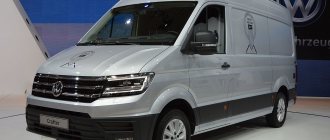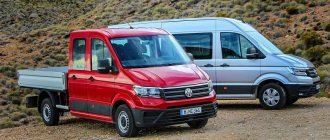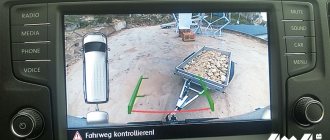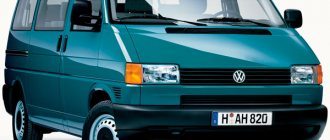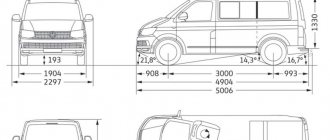Volkswagen Crafter is a family of medium- and light-duty commercial vehicles, including many different modifications. The reliability and versatility of the vehicle ensures its demand among a wide target audience: special services (police, Ministry of Emergency Situations, Ambulance), private clients, medium and small businesses.
The Volkswagen Crafter appeared on the market relatively recently (it debuted in 2006), but has already managed to find its client. Currently, the model is considered one of the most popular in Russia and Europe. Despite huge competition, demand for the series remains consistently high. The reason for this is the optimal combination of quality and price.
Volkswagen Crafter is a modern and multifunctional car that incorporates the best qualities of commercial vehicles: a large range of designs, powerful units, increased safety and excellent performance.
Navigation
PURPOSE
The Volkswagen Crafter series is available in different versions: light truck, minibus and van. “Craft” is translated from English as “craft”, which fully corresponds to the purpose of the van. The main scope of application of the model is the transportation of goods (van and flatbed version) and people (minibus) over various distances. The presence of many versions from an extended body to a small van provides the opportunity to choose a model for specific purposes.
Volkswagen Crafter feels great in Russian realities. Sufficiently high ground clearance and good stability guarantee ease of movement, and an effective heating system allows you to maintain the required temperature in the most severe frosts. Reliability is one of the advantages of the model. Volkswagen Crafter is suitable for everyday use under heavy loads.
Cabin and interior design
Volkswagen Crafter cabin
interior The interior of the Volkswagen Crafter cabin is designed in noble and unpretentious gray tones. The instrument panel is of a classic type, with round windows for the speedometer and tachometer. The gearshift lever does not stick out from the floor, but “goes” under the center console, which gives the cabin more free space.
The Volkswagen cabin has a large number of hidden drawers for documents and small items. Under the seats of the cabin (as well as the cabin, by the way), there are niches for storing large items.
On the center console in the basic version there are no unnecessary instruments, but there is a compartment with two sections of the DIN standard. Any equipment can be installed in them:
- tachograph;
- multimedia system;
- navigation system, etc.
The reach and tilt of the steering wheel is adjusted to the driver’s anthropometric data. The driver's airbag is hidden in the steering wheel. In addition, the front part of the body is specially strengthened to absorb the energy of a frontal impact.
The side rear view mirrors of the Crafter car are divided into 2 segments - upper and lower, which allows you to reduce the “dead zones” to the limit.
In the basic version of the Volkswagen Crafter, the cabin is equipped not only with a stove, but also with air conditioning. At the request of the customer, a split system is installed for the passenger compartment. By default, an air duct for the heating system is installed in the cabin, the heated air from which is directed to the feet of the passengers. The side windows in the saloon open.
The number and arrangement of seats may vary. But for all of them, the Isofix child seat mounting system is provided.
Isofix system for child seats
STORY
The history of Volkswagen Crafter begins in 2006. The series was a continuation of the line of similar cars of the German concern of a smaller class: Volkswagen Caddy and Volkswagen Transporter T5. Product development was carried out by Volkswagen Commercial Vehicles specialists over 3 years. The manufacturer had special hopes for the new series, since it was supposed to replace the legendary Volkswagen LT, which had been on the market for 31 years. The Volkswagen Crafter did not become a complete copy of its predecessor, but received some developments that were used earlier. The developers separated the model into a separate series, completing the history of the Volkswagen LT.
The design of the car immediately caught my eye. Interesting side stripes, made by analogy with muscles, vertical headlights and an impressive body gave the car a brutal look. The picture was completed by a large U-shaped radiator grille, made in accordance with the corporate style of the brand’s products.
It is noteworthy that the assembly of the debut generation of the Volkswagen Crafter was carried out on the same assembly line as the Mercedes Sprinter, which was considered its main competitor. The developers have made every effort to make their “brothers” different. As a result, in comparison with its fragile and elegant counterpart, the Volkswagen Crafter looked much rougher. The internal components of the models also turned out to be different.
In 2011, the series underwent a facelift to ensure compliance with the new style of the brand. The updated versions featured improved ergonomics and finishing materials. In terms of interior decoration and sound insulation, the Volkswagen Crafter is closer to passenger cars. External changes turned out to be minor: improvements affected the headlights and radiator grille. The Russians were offered models with 3 types of turbodiesels with a capacity of 109, 136 and 163 hp.
In 2012, the Volkswagen Crafter 4Motion premiered with all-wheel drive and a 2-liter BiTDI engine producing 162 hp.
In 2016, in Hannover, the German concern announced the second generation Volkswagen Crafter. The appearance of the series retained the same features, but was changed in accordance with the new philosophy of the brand, becoming more strict. The clean lines of the grille and tapered LED headlights complete the new look. With the change of generations, the series has completely moved away from its “kinship” with the Mercedes Sprinter. The Volkswagen Crafter 2 appeared on the Russian market in 2022 in several versions.
Van
The Volkswagen Crafter van is offered in 2 main versions: the Kombi cargo-passenger model and the all-metal van. Several dozen configurations are available for each.
The van is available in 3 lengths, 3 cab heights and 3 wheelbases. Overall length, depending on the version, varies from 5986 mm to 7391 mm, height - from 2355 to 2798 mm. All versions have the same width – 2040 mm. The wheelbase of the van is within the range of 3640-4490 mm. The ground clearance of the series is 195 mm.
The total weight of the van is 3000-5000 kg. Behind the seats, the car has an impressive compartment that can accommodate 9.9-18.4 cubic meters of cargo. Access is via a sliding side door or hinged rear doors.
The Kombi variation has similar dimensions and weights, but differs in the presence of additional seats for passengers. The car can accommodate up to 7 people, including the driver.
Basic information, characteristics
- Manufacturer/manufacturer where the equipment is produced/manufactured. Volkswagen Aktiengesellschaft is a German automobile concern (group of companies). The company's headquarters is located in Wolfsburg.
- Purpose. City, intercity, tourist, special, school, ritual.
- Class. Small.
- Body type. Carrier.
Freight car
The Volkswagen Crafter Pritsche version is a compact two-axle truck with front-, rear- or all-wheel drive. The series is perfect for transporting various cargoes, and its main advantage is its excellent technical and operational characteristics.
For the Volkswagen Crafter cargo series, there are 3 length variations and 2 cab options (double and basic).
Dimensions:
- length – 6204-7404 mm;
- width – 2098 mm;
- height – 2305-2330 mm;
- wheelbase – 3640-4490 mm;
- ground clearance - 195 mm.
The total weight of the Volkswagen Crafter Pritsche is no different from other models in the series and lies in the range of 3000-5000 kg.
With the base cab, the car can seat 2 people. Double cab versions include a 4-seater sofa in the second row.
As a standard version, the Volkswagen Crafter cargo truck is equipped with an onboard platform that has the following parameters:
- length – 2700-4300 mm;
- width – 2040 mm;
- side height – 400 mm;
- total body area – 5.5-9.6 sq.m.
Passenger version
The passenger Volkswagen Crafter is available in several versions and is used for transporting people.
Overall dimensions (including version):
- length (Short/Medium/Long/Super Long) – 5240/5905/6940/7340 mm;
- wheelbase (Short/Medium/Long/Super Long) – 3250/3665/4325/4325 mm;
- cargo compartment length (Short/Medium/Long/Super Long) – 2600/3265/4300/4700 mm;
- width (Short/Medium/Long/Super Long) – 1993 mm;
- ground clearance (Short/Medium/Long/Super Long) – 195 mm.
The height of the car depends on the version and varies from 2415 to 2990 mm.
Total weight – 3000-5000 kg. Load capacity – 1500 kg. The total capacity of the minibus is 9-27 people.
Specifications
There are 4 versions of the passenger Volkswagen Crafter, differing in length and carrying capacity.
- Short - length 5240 mm.
- Medium - length 5905 mm.
- Long – 6940 mm.
- Super Long – 7340 millimeters.
Height varies. It varies from 2415 to 2990 mm. But the width of the car in all cases remains the same - 199.3 cm. The wheelbase of the “long” models is 432.5 m, while that of the Short and Medium is proportionally reduced.
The load capacity is one and a half tons (the “long” versions have a little more). Total maximum weight - from 3000 to 5000 kg. The maximum volume of the cargo-passenger compartment (a “super long” car with the highest roof) is 17 cubic meters.
Volkswagen Crafter is very convenient for the driver and comfortable for the personnel
A car with a high roof is convenient for transporting standing passengers.
Most Russian carriers prefer to purchase Long and Superlong modifications, since they allow them to accommodate a larger number of passengers.
The remaining technical characteristics of the Volkswagen Crafter of all models are identical.
The engine is gasoline, with a common rail direct injection system. The engine capacity is 2 liters. It is the same for both the five-cylinder TDI engine (in the 2011 Volkswagen Crafter versions) and the four-cylinder BiTDI in later versions. The power range is from 109 to 163 hp. With. The drive is rear-wheel drive, the maximum speed is 156 km/h.
Main components of the Common Rail system
The car is equipped with a 6-speed manual transmission or a robotic gearbox manufactured by Mersedes.
ENGINE
The line of power plants for the Volkswagen Crafter series includes 4 engines of the same volume running on diesel fuel. The engines use a Common Rail injection system, which provides high efficiency indicators. Optionally, the units are equipped with the Bluemotion system, which allows for even lower fuel consumption. All engines are equipped with special particulate filters, which is especially important for Russian operating conditions. Another feature of the units is the presence of 2 turbines that turn on and off sequentially. At lower speeds, a smaller turbine operates for faster acceleration; at higher speeds, a larger turbine operates. This ensures smooth traction regardless of operating mode.
Structurally, the engines for Volkswagen Crafter models are practically no different and are an in-line “four” with direct fuel injection. The units comply with environmental standards Euro-4 and Euro-5. Unpretentious, but less environmentally friendly options (Euro-4) are offered for the Russian market.
Detailed description, device
Volkswagen Crafter is a small-class bus designed for transporting passengers on urban and intercity routes, which combines a laconic design, high capacity, strong and reliable design and excellent technical and operational characteristics.
The passenger version is offered in several modifications, differing from each other in length, roof height and wheelbase.
The body is covered with a special paint coating applied using a new technology that ensures long-term preservation.
Interior of a Volkswagen Crafter bus. Photos of Volkswagen AG
Inside, the Volkswagen Crafter greets its occupants with a modern and discreet design , impeccably thought-out ergonomics, high build quality and high-quality finishing materials. A large four-spoke steering wheel, laconic and easily readable instrumentation, a massive center console on which all the controls are intelligently arranged - you can’t immediately say that this interior belongs to a purely utilitarian car.
By default, in the front part of the cabin there are two or three single seats with a comfortable profile, headrests and three-point seat belts.
Initially, the Volkswagen Crafter was offered exclusively with a 2.5-liter turbodiesel. However, along with the facelift that took place in 2011, the family’s engine range was expanded. It featured three 2-liter TDI engines with 109, 136 and 163 hp. The power plants used an advanced Common Rail injection system , which had a qualitative impact on fuel consumption. Even in the mixed cycle, the unit showed the highest savings . An optional Bluemotion system was installed, which made fuel consumption incredibly low. The new diesel engines had a maximum torque of 360-400 Nm. Moreover, it remained high even at low speeds.
All units were equipped with particulate filters, which is very important for Russian realities with poor fuel quality. This unit uses a 4-cylinder design. The motors comply with the environmental classes Euro-4 and Euro-5.
Units with a capacity of 136 and 163 hp. have an advanced operating principle of turbocharging . It uses 2 turbines that turn on and off sequentially. At low speeds, a small turbine is used, providing rapid acceleration, and with increasing speed, a large one is activated. This ensures even and smooth traction at all times. A similar system is used in the Volkswagen Caravel.
The Volkswagen Crafter's suspension has undergone major changes. The front suspension (independent, McPherson) received less weight and better stabilization due to a change in the material of the transverse leaf spring, which was made from fiberglass. Due to soundproofing gaskets and rubber bearings, noise and vibration are practically not felt in the cabin. The rear suspension (dependent) includes 2 longitudinal springs shifted outward. A rear axle stabilizer is offered as an option. Rubber bearings are installed exclusively on buses.
The model received ventilated disc brakes at the front and disc brakes at the rear. Improvements have made it possible to reduce braking distances and ensure traffic safety.
The transmission used is robotic gearboxes or 6-speed manual gearboxes. Gear shifting is carried out using a joystick, which works extremely clearly and is conveniently located in the driver’s hand. If reverse gear is accidentally engaged, the lock is automatically activated.
Unit characteristics:
- TDI (low power). Displacement – 2 liters, rated power – 80 (102) kW (hp), fuel consumption (highway/combined/city) – 7.9/8.3/9.1 liters per 100 km;
- TDI (medium power). Displacement – 2 liters, rated power – 100 (122) kW (hp), fuel consumption (highway/combined cycle/city) – 7.9/8.3/9.1 liters per 100 km;
- TDI (high power). Displacement – 2 liters, rated power – 115 (140) kW (hp), fuel consumption (highway/combined cycle/city) – 7.6/8.4/9.9 liters per 100 km;
- BiTDI. Displacement volume – 2 liters, rated power – 120 (177) kW (hp), fuel consumption (highway/combined cycle/city) – 7.3/7.9/8.9 liters per 100 km;
For the Russian market, starting from 2022, power plants of 2 options with a rated power of 102 and 140 hp are offered. (maximum torque – 300 and 340 Nm, respectively).
Engine/powertrain characteristics
- Model. 2.0 TDI CR; 2.0 BiTDI CR.
- Type. Turbodiesel.
- Number and arrangement of cylinders. 4, in-line.
- Environmental safety standards. Euro-4, Euro-5.
- Working volume, l. 2.
- Engine power, kW (hp)/min. 109 hp (80 kW); 136 hp (100 kW);
- Maximum torque, Nm/min. 300; 340; 400.
- Engine location. Anterior, longitudinal.
- Checkpoint. 6 manual transmission.
- Maximum speed, km/h. 144.
Chassis
Volkswagen Crafter is built on the MQB A/B digital platform. The suspension has remained virtually unchanged compared to the first generation. The front part uses a classic design, which includes independent suspension, a transverse stabilizer and MacPherson struts. The rear uses a dependent architecture with durable plastic springs supported by a driven beam or drive axle. For standard versions, a single-leaf spring is used; for vehicles with a higher load capacity and twin wheels, a three-leaf spring is used. In front-wheel drive versions, the engine is located transversely, in rear-wheel drive versions – longitudinally. On Russian roads, the Volkswagen Crafter feels very good; when driving, shaking in the cabin is practically not felt, since the car “swallows” bumps.
Transmission
The basic version is equipped with a 6-speed manual transmission. Robotic transmissions are also available. Selecting speeds is done using the joystick, which is located next to the panel. Gear shifting is carried out without much effort; if reverse gear is accidentally selected, the lock is automatically activated.
Only a manual transmission is available for Russian consumers.
The series is offered with 3 types of drives: front, rear and all-wheel drive (4Motion and Haldex multi-plate clutch).
Brake system
The wheels of the Volkswagen Crafter 2 are equipped with disc brake elements all around. For modifications with a large load capacity, ventilated mechanisms are used in the front and rear. The car is equipped with an electronic adaptive system that ensures directional guidance in lane markings, an emergency braking warning signal and a recommended gear indicator. The braking system also includes ASR (anti-traction control), EDL (electronic differential lock) and ABS (anti-lock braking system).
Salon
Volkswagen Crafter is offered with several interior options with different types of trim. The car has a spacious interior with comfortable seats for passengers and the driver. The driver's seat is adjustable in depth and height. The steering column also has several adjustments (reach, tilt angle).
The interior of the series is decorated in gray tones. The driver's area is equipped with a classic-type instrument panel with a round tachometer and speedometer. The gear shift lever is located at the center console. The cabin has many hidden drawers for small items and documents. Under the seats, including the passenger seats, there are storage niches.
In the initial version, the Volkswagen Crafter is equipped with a heating system and air conditioning. An optional split system is available for the passenger area. In the passenger compartment (minibus version), a heating duct is installed by default, through which warm air flows to the passengers’ feet. The number of seats in the cabin may vary and depends on the modification. The seats are equipped with an Isofix child seat fastening system. The developers also did not forget about heated windshield and steering wheel (optional). Other interesting functions are optionally available.
Equipment
Interior of a Volkswagen Crafter bus. Photos of Volkswagen AG
Standard equipment:
- Thermal, noise and vibration insulation of ceilings, doors and walls
- Combined finishing of side panels: bottom – floor covering; top, doors – composite panels trimmed with fabric; waist line – fabric trim;
- Passenger compartment roof panels - fabric trim
- A 40 cm high partition between the driver’s workplace and the passenger compartment.
- Threshold with decorative lighting at the right sliding door.
- Sliding door side step.
- Floor with podium.
- Illumination of podiums (along the perimeter).
- Moisture-resistant, antistatic, non-slip flooring.
- Panoramic glazing.
- Windows.
- Handrails in the cabin.
- Passenger leg protection.
- Ventilation emergency hatch.
- Independent interior air heater.
- Filter ventilation installation.
- Lighting ceiling lamps.
- Stop on demand buttons.
- The passenger seats are anatomical, with fabric trim and seat belts.
- Three-point seat belts on the first three seats located in the direction of travel; two-point inertia on the remaining seats.
- First aid kit.
- Fire extinguisher.
- Emergency exit hammer.
- Necessary stickers in the cabin.
- Curtains for the windows.
- Rear door locking device.
